
Vanessa Hoche
Keywords: Slowness, Sensory experience, Embodied ritual
www.instagram.com/vanessahoche/#
atelierhoche@gmail.com
website
I heard the sound of sand and stayed is a project that explores how spatial design can create moments of presence in an overstimulated society. With Research on sensory experience, rituals and the in-between moments, this installation invites into presence, slowness and time.
The space draws inspiration from time-based research on Japanese tea houses, architectural promenades and sensory architecture. It translates elements like light, isolation, movement, rituals, and sensory awareness into an immersive installation. A fabric spiral lets the visitor shift from movement to stillness, from noise to quiet, from doing to being. New sensations gradually unfold, like slowness does.
The spiral refers to ancient symbols of transformation and inward journeying. It gently choreographs the body, slowing it down. Around each curve, something new arises: a subtle scent, a shift in temperature, or the warm light coming through the fabric.
Sand slows movement naturally. It grounds, remembers touch, and evokes memories of play, of presence, of summer, earth, and impermanence. The pendulum above shows time not by counting, but by making it visible. The movement leaves traces that will disappear again, like all moments do.


The project expresses the need for “Zwischenräume”, the in-between spaces, between busy and rest, public and private, mind and body. They offer time for grounding, reflecting, and breathing.
It offers a temporary in-between space. Located in different parts of the city, it creates a moment to breathe. Especially for neurodivergent people, who may experience sensory overwhelm. But also for anyone carrying tension.
The choice of an empty shop as the location is on purpose. Spaces, designed for consumption, become here spaces for contemplation. By placing a non-productive space inside a commercial building, I quietly criticize our need for productivity.
It asks, what happens when we slow down for a moment?